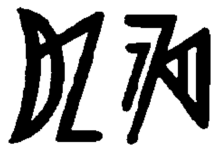Sani language
| Sani | |
|---|---|
| nɪ˨˩ do˨˩ | |
 Sani written in Yi script | |
| Native to | China |
| Ethnicity | Yi |
Native speakers | 100,000 (2007)[1] |
Sino-Tibetan
| |
| Yi script | |
| Language codes | |
| ISO 639-3 | ysn |
| Glottolog | sani1269 |
Sani (
The Sani [sa˨˩ni˨˩] call themselves [ni21]. Their language is distinct from the closely related Samei, whose speakers call themselves Sani [sa21 ni53].[1]
Another group known as the Sa 撒 (
Shilin County
. The ethnic population consisted of 1,443 as of 1960.
Innovations
Pelkey (2011:378) defines two innovations that Sani and Axi both share with each other.
- Exclusive devoicing of tone category 1 proto-voiced initials (even if there is voiced retention in tone category 2). These words include 'fly (v.)', 'wing', 'bridge', and 'liquor'.
- Dominant -e/-ɛ reflexes of *-ak rhymes.
References
- ^ a b Sani at Ethnologue (18th ed., 2015) (subscription required)
- ISBN 7540927658
- ^ Yunnan minzu shibie zonghe diaocha zubian 云南民族识别综合调查组编 (1960).Yunnan minzu shibie zonghe diaocha baogao 云南民族识别综合调查报告. Kunming: Yunnan minzu shibie zonghe diaochazu 云南民族识别综合调查组.
- Pelkey, Jamin. 2011. Dialectology as Dialectic: Interpreting Phula Variation. Berlin: De Gruyter Mouton.
- Ma Xueliang 马学良. 1951. Sani Yiyu yanjiu 撒尼彝语研究. Beijing: Commercial Press 商务印书馆.

